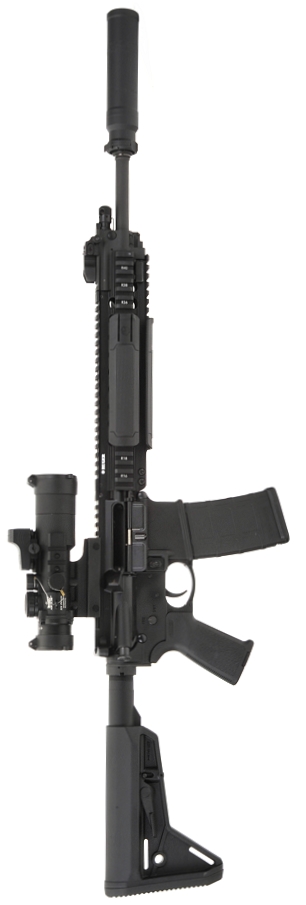
We have covered silencers and suppressing the 45 Auto pistol and .300 Blackout rifle, so it seemed time to address suppressing a small bore rifle. We selected a Mayodan, North Carolina manufactured Ruger SR 556TD for this project because it takes only a handful of seconds to switch between 300 Blackout to a 5.56 NATO capability.
The project’s objective is not to conduct a technical assessment of this silencer. While much is published on the Internet that purports that intention, in only rare exceptions are valid and they are conducted using expensive test equipment and under lab conditions. In those cases, the results are interpreted by folks with advanced engineering skills in related disciplines. The intention here is to qualify performance by what our ears can hear, what a chronograph can record and by measurement of groups shot on targets.
Like a 22 rimfire, only expensive?
Subsonic loading of light bullet 223 Remington cartridges seems a colossal waste of time and energy. The gas volume and pressure is too low to cycle a modern sporting rifle so, unless it is the only firearm available for the subsonic duty, a .22 rimfire rifle with subsonic ammo would be a better choice. However, heavier 22 caliber bullets, loaded to the high end of subsonic velocity, offers some advantages.
A 75 grain bullet is more streamlined than a 40 grain rimfire bullet, which means higher BC, which should mean greater retention of velocity and all that follows; shorter time in flight, flatter trajectory, greater crosswind resistance. However, in both cases there is so little downrange performance expectation, a slicker BC offers little practical value with 107 yard point blank range for the rimfire and 111 yards for the 75 grain centerfire. With an optimal zero, at 200 yards, drop is 42″ and 35″ respectively… flatter trajectory.
A 22 caliber rimfire 40 grain bullet, generates 98 ft-lbs of muzzle energy at 1050 fps. A 223 Remington 75 grain bullet driven to the same velocity generates 184 ft-lbs. At 200 yards the kinetic energy gap has broadened to 64 ft-lbs and 150 ft-lbs. At 200 yards the rimfire generates only 0.15 lb-sec of momentum while the while the 75 grain centerfire generates 0.31… the 75 grain offers greater penetration.
So why not move up to a 22 Magnum or one of the hot 17 caliber rimfires? As the velocity is limited to less than the speed of sound for maximum suppression of report, approximately 1,125 feet per second at sea level, if more power is desired it must come from greater bullet weight at the same subsonic velocity. So ammunition was assembled, a lunch was packed, and serious assessment followed.
The Advanced Armament Corp’s SR 5
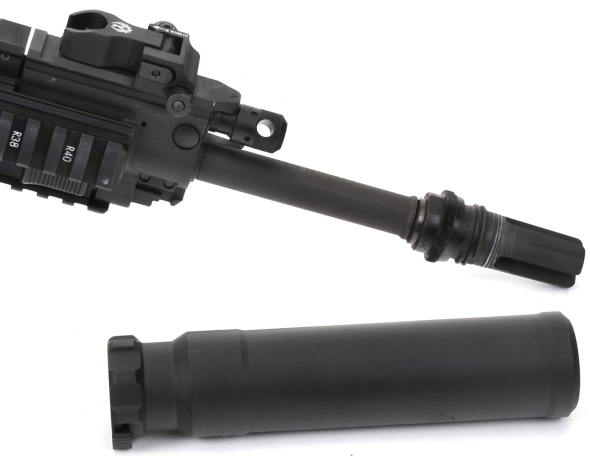
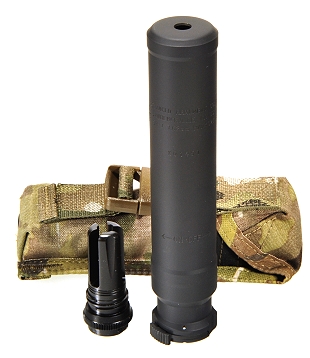
The Advanced Armament SR-5 is supplied as a small kit with 90T 1/2×28 Blackout® Flash Hider Mount, stow pouch, manuals and installation/removal instructions, just like the SR-7 kit pictured, left.
As pictured above, installation on the Ruger took less than 10 minutes and made no permanent changes to the firearm. Advanced Armament Corp includes Rocksett as a thread locker to make sure the flash hider stays put at even temperature extremes, up to 2,000ºF.
Within the confines of this project, the Ruger SR 556’s flash suppressor was removed and the AAC flash hider was torqued to spec against the Ruger’s crush washer. That proved to be enough to keep everything tight throughout live fire. I am not suggesting that the thread locker step be omitted as manufacturers who design and test products always know best when it comes to installation and use.
|
Model |
SR-5 |
| Calibers | 5.56 NATO |
| Weight | 17.5Oz. |
| Length Full/Compact | 6.70“ |
| Tube Diameter | 1.50″ |
| Tube Material | Blackened 316L SS |
| Baffle Core | Iconel 718 |
| Assembly | Welded |
| Attachment | 90T Fast-Attach |
| Sound Reduction | 32dB to 34 dB |
| MSRP | $1,095.99 |
The Advanced Armament Corp SR-5 is very similar to the SR-7 differing only in overall length and amount of internal baffling, internal volume and bore size. Like the SR-7, the SR-5 is a welded unit; no disassembly of baffle systems for cleaning. Cleaning is accomplished by immersing the silencer is a container of solvent, scrubbing the visible surfaces with a nylon scrub brush and they flushing out with hot water and detergent. AAC notes that, in their testing, no degradation of performance was noted even after 30,000 rounds were fired so cleaning is not a routine maintenance item.
The Burris AR-536 5x magnification prism sight was carried over from the SR-7 installation and on target with minor zeroing adjustment for the cartridge change shift in point of impact. As noted previously in this series, the AR-536 is not a red dot sight, but rather closer to a traditional telescopic sight. The primary mechanical difference is that the task of correcting image inversion is accomplished by a prism rather than an erector tube and lens system. The reticle is exceptional and illuminates, red and green. Without power, the same reticle appears in black.
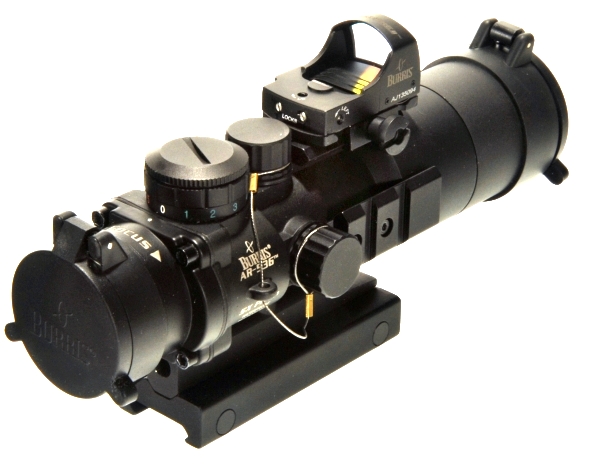
Performance, silencer on/off supersonic velocity
| Cartridge | Bullet Type |
Bullet Weight Grains |
Not Suppressed MV FPS |
3 Shot Group “ |
Suppressed MV FPS |
3 Shot Group “ |
| Winchester VarmintX | Poly Tip | 40 | 3430 | 1.0 | 3423 | 0.9 |
| Remington UMC | JHP | 50 | 3172 | 0.7 | 3167 | 0.9 |
| American Eagle | SP | 50 | 3002 | 0.9 | 3035 | 1.0 |
| Hornady Superformance Varmint | Poly Tip | 53 | 3221 | 1.0 | 3202 | 0.8 |
| PMC XTAC | Green Tip LAP | 62 | 2900 | 1.1 | 2906 | 1.2 |
| PPU Match | HPBT | 69 | 2643 | 0.7 | 2662 | 0.8 |
|
Velocity recorded 10′ from muzzle with calibrated chronograph. Groups shot at 100 yards. |
||||||
Within the realm of this project, the ballistic gain/loss of shooting through a silencer is statistically nonexistent as there were only minor variations and none were consistent enough to graph. So I will go out on a limb here and say that use of the Advanced Armament Corp silencer in this configuration does not hamper the performance of a firearm and the decrease in report may very well result in improved shooter concentration and accuracy.
The factory ammunition noted above is supersonic. The reduction in report with the SR-5 in place was significant, although not as much as the suppressed 300 Blackout supersonic loads shot in the priorproject installment. I would suggest the suppressed report of the .223 Remington version as something akin to a rifle firing 22 long rifle rimfire ammunition. My perception, not measured.
So, 223 Remington subsonic handloads… That was fun
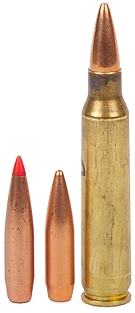
The 75 grain Hornady Match selected, center, rather than the 75 grain Hornady A-Max, far left. Based on bullet length and ogive profile, the A-Max requires a COL of 2.390″, well beyond the SAAMI COL of 2.260″, which will not fit standard magazines. None of the subsonic loads produced the enough gas volume or pressure to cycle the SR 556.
Most of the subsonic data for the 223 Remington is for 50 grain bullets and they are not useful when creating derivative heavier bullet loads, as workup does not follow the typical relationship of increased bullet weight requiring a decrease in powder. Charges needed to be increased to overcome additional bore friction resulting from the heavier bullet’s larger bearing surface. All powder charges are low density, leaving lots of empty case volume.
Hodgdon lists three low density / low pressure tolerant powders for subsonic 50 grain bullet 223 Remington handloads: Clays, TiteGroup and Trail Boss. All three function well as low pressure, low density charges. Trail Boss has the added benefit of being a bulky powder that takes up a lot of case capacity. For the purpose of illustration only – below are 4 grains of left, Trail Boss, right, Power pistol. In addition to staying inside the SAAMI COL spec, the short 75 grain bullet was better stabilized by the 1:9″ twist rifling.

The project goal was to stay under supersonic velocity, achieve consistent performance and have enough start pressure to avoid having to poke stuck bullets out of the gun’s bore… like the one below.

The first two sets of preliminary loads were based on published 50 grain bullet Hodgdon loads; I left the charges the same in hopes of bumping pressure sufficiently to overcome bore friction. The first reading was 780 fps, the next was 823 fps and the third stopped 3″ from the muzzle and waited for me to remove it. During all accuracy and velocity checking a white piece of paper was kept in front of the rifle so a bullet leaving the barrel could be verified. A discharge that resulted in a bullet not exiting the rifle’s barrel did not make sound, there was no chronograph reading and there was no hole in the paper ahead of the muzzle.
All was not lost as the report was Hollywood silencer quiet. In fact, since the bolt did not cycle, the only sound I heard was the click of the firing pin striking the round’s primer. The rifle was so quiet I taped a piece of white paper on the back sides of the rear chronograph screen so I would know, without a doubt, that the bullet left the barrel. In addition to the wide velocity variations, I could also see from the imprint on the paper that the bullet was tumbling. So I bumped the charge a bit, then bumped it again until they looked as they do on the table below.
 |
Warning: Bullet selections are specific, and loads are not valid with substitutions of different bullets of the same weight. Variations in bullet material and length will alter net case capacity, pressure and velocity results. Primer selection is specific and primer types are not interchangeable. These data represents maximum loads in our firearms and test equipment and may easily be excessive in other applications. All loads should be reduced by 3%, and developed following safe handloading practices as represented in established reloading manuals produced by component manufacturers. Presentation of these loads does not constitute a solicitation for their use, nor a recommendation.
|
||||||||||||||||||||||||||||||||||||||||||||||||||
|
|||||||||||||||||||||||||||||||||||||||||||||||||||
At 5.5 grains, bullets left the rifle’s bore reliably and consistently. Accuracy was so – so. At 6 grains accuracy dramatically improved, muzzle report was still non-existent and the Advanced Armament Corp silencer certainly did its job with only a dull click marking each subsonic discharge.
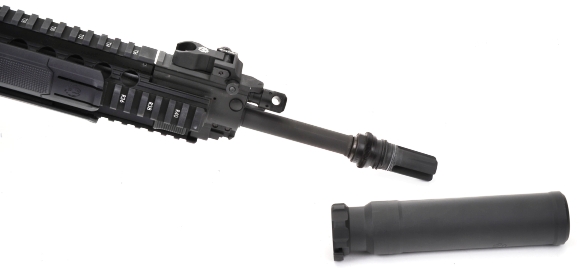
Experiencing the combination of rifle, ammo and silencer, I can see a good deal of utility. For home defense, the lack of noise would provide a major edge. The same could be said for hunting or just spending hours at a rifle range.
Silenced Modern Sporting Rifles Part 1
Silenced Modern Sporting Rifles Part 2
Silenced Modern Sporting Rifles Part 3

Email Notification